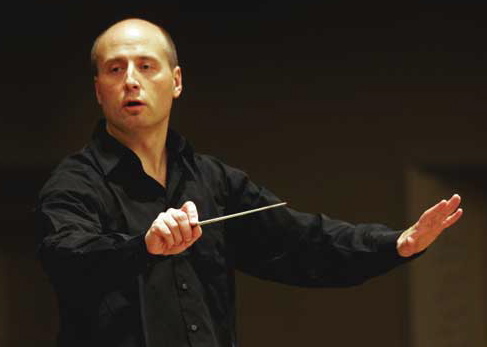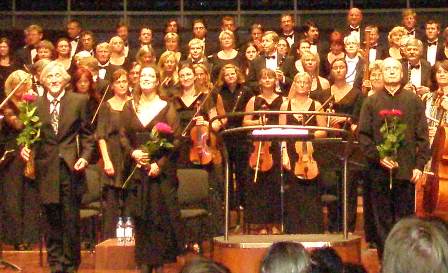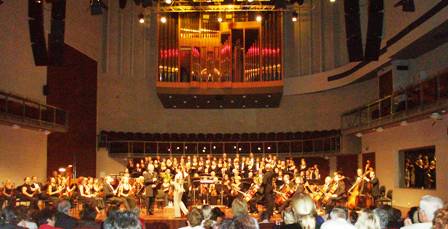Remembering David Oistrakh and Brahms
Mary Ellyn Hutton
Posted: Aug 10, 2008 - 11:16:41 AM in
reviews_2008

Paavo Järvi
|
Pärnu, Estonia.
Among the themes uniting the 2008 David Oistrakh Festival in Pärnu, Estonia was Johannes Brahms.
Not only is 2008 the 175th anniversary of Brahms’ birth, but Oistrakh was playing and conducting a Brahms Festival when felled by a heart attack in Amsterdam in 1974.
There was music by Brahms on four of the 13 festival concerts (not counting Brahms’ Hungarian Dance No. 5 performed by the Slovakian “Gypsy Devils” July 21).
The main event, with the Latvian National Symphony Orchestra conducted by Paavo Järvi, took place July 27 in Pärnu Concert Hall.
The concert opened with the Double Concerto, a poignant choice since Oistrakh’s scheduled performance of the work in Amsterdam in 1974 was canceled in the wake of his death. It closed with the German Requiem.
Järvi, who at 45, combines rare musical insight with the highest technical and communicative skills, led with precision and emotional conviction. He had significant forces at his command: Well known Japanese violinist Akiko Suwanai and Lithuanian-born cellist David Geringas were soloists in the Double Concerto. Geringas, a Rostropovich protégé who has (or appears to have) confined his career to Europe and Asia, has so far left U.S. audiences poorer by his absence. The State Choir “Latvija,” without doubt one of the world’s best mixed choirs, made the Requiem a performance to treasure. Soloists were Russian soprano Alexandra Luchansky and Finnish baritone Esa Ruuttunen.
Geringas filled his opening solo in the concerto with passion, matching the dramatic tone set by Järvi and the fine Latvian Orchestra. Suwanai, who can produce a vibrant, encompassing sound without obvious effort, followed in kind for a movement kindled with feeling. The Andante flowed warmly from it, the soloists initially in unison, giving the work a tender touch.
Geringas, who owns an amazingly fluid technique as well as a huge sound, introduced the finale’s obsessive rhythmic theme. Excitement grew as the music built to a noble, climactic ending with the cello playing in a higher register than the violin for a delicious effect.

L to R: Baritone Esa Ruuttenen, soprano Alexandra Lubchansky and conductor Paavo Järvi with the Latvian National Symphony Orchestra and State Choir "Latvija"
|
Brahms’ Requiem poses a challenge for interpreters since it is not a traditional, liturgical requiem. Composed in response to the death of his mother and composer Robert Schumann, it seeks to assuage grief and offer reflection (the opening bars even hint at the German national anthem). The clarity and fullness of sound of the Latvian Choir struck this listener dumb from the opening bars, and it was remarkable how quickly and easily they responded to his directions.
The second movement (“for all flesh is grass”) sometimes comes across ponderously, like a weighty dirge. Jarvi paced it beautifully, neither too slow nor too fast, building from bleakness to blistering intensity and giving it a satisfying musical as well as emotional shape.
Balances and blends were carefully crafted throughout – no problem with this chorus. And Järvi never neglected orchestral colors, such as the bobbing clarinet near the end of “How lovely are thy dwelling places,” the tuba, fundamental to the soaring lines of “Thou art worthy, O Lord, to receive glory and honor and power” and of course, the all-important sprinkles of harp.
Ruuttenen and Lubchansky sang with great conviction. The very biblical-looking Ruuttenen (white hair and beard) projected compassion and authority in “Lord, make me to know mine end.” Luchansky warmly enfolded the chorus on the references to a mother’s love in “Ye now have sorrow” and there was an almost magical blend between her voice and the clarinet at the end.
Brahms transforms the fire and judgment of the Latin Requiem into comfort and joy. “Thou art worthy to receive glory and honor and power” rose through the orchestra and chorus like something out of Handel’s “Messiah” (which uses the same text from Revelation).
The final movement, “Blessed are the dead who die in the Lord,” was a benediction, the violins raining down on the chorus like a wordless descant. Unlike some, Järvi saved the fullest expression of this stirring passage for its repeat near the end.

Brahms' German Requiem, Pärnu Concert Hall July 27, 2008
|
Even the lighting in the hall (which seats 900, with splendid acoustics) lent a subliminal effect, with subtle colors (reds, greens and golds during pedal points, i.e. (passages of static harmony over long-held bass notes) reflecting from the organ pipes behind the orchestra.



